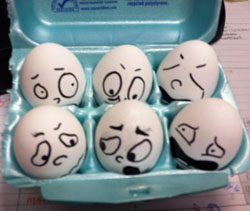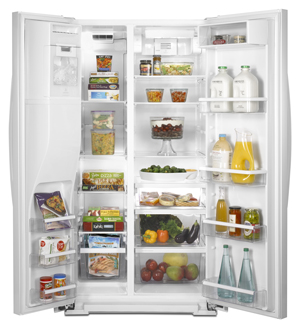Groceries . . . you need them. You’ve made your shopping list, carefully conquered the grocery store, reading labels, finding sale items, using your coupons to get good prices. You’ve paid for all your goodies, bagged them and driven them halfway across town. After lugging them in, and perching them precariously on the counter top you think, “Where do I stash all of my loot?” Home-Tech is here to offer you some practical refrigerator storage solutions.
To get the most out of the money you’ve spent and to get the most flavor and nutritional value from your foods, as well as “keep it fresh” storage time, everything needs to go in just the right place in the refrigerator. With today’s refrigerators having so many drawers and special storage options, sometimes it can get confusing as to how to best store everything. That’s why these refrigerator storage solutions will help you reorganize your fridge and regain control of your kitchen.
Table of Contents
Let’s Start at the Top
We are talking about the very top (that is, on top) of your refrigerator. It seems like a natural place to stash items that don’t need to be inside the refrigerator, but the fact is, it’s quite warm up there. It’s not a good place for loaves of bread or bottles of wine or any food types for that matter. It would be a good place to let a home-made loaf of bread rise.
One “Hot Ride”
The door compartments are the warmest places inside of the refrigerator. Even though you may have little egg holders or a butter compartment or a spot for a gallon of milk, it is best not to store any of these items in the door. These foods are very sensitive to heat and temperature changes.
Did you know that milk can go bad in just two hours if it is sitting out? Every time someone opens the fridge door, everything riding in it, gets blasted by hot air. So keep your eggs, butter and milk deep in the heart of the refrigerator. The door is the perfect spot for condiments which contain lots of preservatives, as well as olive oil, pasteurized fruit juices, soda, bottled water, and opened bottles of wine.
Where’s the Beef?
When you bring home fresh meats, fish or poultry from the grocery store, the packaging could have dangerous bacteria on it. Therefore, it’s very important that the meats don’t touch the other groceries and that they stay very cold. Keep them in the grocery store packaging on the lowest shelf of the refrigerator, so the juices can’t drip down on any other foods. It’s best to keep them each wrapped in an extra layer of plastic, like a grocery bag. Did you know that fresh fish can only keep for 1 day in your fridge? Be sure to freeze it, if you can’t cook it that same day. Also, if you are unthawing frozen meats, do it on the lowest shelf of the refrigerator.
 The Crispy Catch All
The Crispy Catch All
Most refrigerators have at least one crisper drawer. The purpose of the crisper drawer is to keep the humidity in, thus making it the perfect place for fruits and vegetables. Have you ever noticed how they “mist” the vegetables at the grocery store? Once the fresh veggies and fruits are picked they start to ripen and dry out. Keep your fruit in one drawer and your veggies in another as they ripen differently from each other. Ripening apples actually give off a gas that can cause your veggies to deteriorate. Did you know that you don’t have to refrigerate your fruits until they start softening?
Most fruits freshly bought are not quite ripe yet. They do best ripening on the counter top. Then transfer them to the crisper when they soften. Even a banana can be put in the crisper after it is just ripe enough. Yes, the peel will turn brown, but the inside will stay just right. Fresh lettuce should stay crisp for a week in the crisper drawer. Citrus, pineapples, berries, grapes, cherries and watermelon just start going bad after they’ve been picked, so get them in the crisper right away. Finally, don’t wash your fresh produce before you store it. It could lead to the growth of mold.
A Quick Get-Away
Refrigerator storage solutions are supposed to make your life easier, right? Ideally you want to open the refrigerator door as little as possible. When the door is open, the temperature is fluctuating, (and energy/money is pouring out) so it’s best to get in and get out as quickly as possible. Put the small items that you use frequently together, on the same shelf, at eye level, like yogurts, dip containers, snacks and small items that easily get lost for quick grabs.
The Doggie Bag
Leftovers can be a good thing (I don’t have to cook tonight), an interesting thing (hmmm, look at that science project) or a bad thing (spoiled food making you sick). Be sure to store all leftover foods within 2 hours of cooking them in small flat containers with lids. Today’s refrigerators can cool foods quickly. So, it’s ok to put piping hot leftovers in the fridge for safe storage. This refrigerator storage solution will help you save money and have more convenience on week nights!
It’s Full of It
It is ok to have the refrigerator full of foods. But don’t overload it. Cool air needs to be able to circulate around the food items to keep them at the correct temperature. Speaking of temperature, your refrigerator should keep your foods at 40°. You can determine if your temperature is correct by placing a refrigerator thermostat in a glass of water in the refrigerator overnight. Go ahead and test each shelf to be sure that each area is cool enough.
You’ve Lost That Loving Feeling
If your current refrigerator isn’t working correctly and these refrigerator storage solutions just aren’t cutting it, Home-Tech is here to help you with a repair or to purchase a new one. Our Appliance Specialists know everything about refrigeration and will be happy to show you the latest models in our Member Appliance Center. Can’t stop by? Enjoy our Online Appliance Store.

